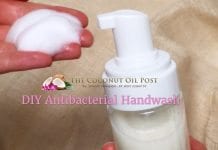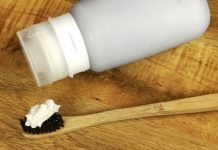Coconut oil for soap has been used for years by most manufacturers producing soap products. Coconut oil produces the best quality and richest lather soaps. Coconut oil soaps will even produce a rich lather when used in the hardest of water including saltwater. Soaps made with coconut oil are naturally antibacterial as they contain medium chain fatty acids that kill germs.
Making your own coconut oil soap is easy. To make your own soap you will need coconut oil, lye (also known as caustic soda), water and fragrance if using.
Follow this recipe for a delightful handsoap.
Precaution: Lye or caustic soda will cause severe burns if it comes in contact with the skin. It is recommended that you use rubber gloves, protective eyewear and work in a well ventilated area. Use extreme care while making your homemade coconut oil soap.
Coconut oil soap

Homemade coconut oil soap perfect for every skin. This recipe comes from the book “Coconut Cures” from Bruce Fife.
- Kitchen scale
- 1 litre mason jar
- Stainless steel or Pyrex saucepan
- Stainless steel or wooden spoon
- Candy thermometer
- Soap mold
- 6 ounces water
- 2.6 ounces lye
- 16 ounces coconut oil
- Essential oil for fragrance
- Weigh out each ingredient as precise as you can make it. It won’t matter if its 1 or 2 tenths out but it will matter if it’s 1/2 ounce. Get as close as you can.
- Put the water into the mason jar. Be careful not to breathe the fumes. The water will become very hot.
- Place it aside to cool.
- Put the coconut oil into the saucepan and heat to between 100 and 130 degrees F (38-54 C). If you don’t have a candy thermometer, you can judge temperature by touch. It should be very warm, yet not so hot that you can’t put your finger into the oil.
- When the caustic soda solution has cooled to between room temperature and 95 degrees F (35C) – slowly pour the caustic soda solution into the oil, stirring constantly.
- The soap solution will be clear at first. As it cools it will slowly thicken and become white. It needs to become as thick as a milkshake which may take a couple of hours. Check it often and stir frequently to prevent it from developing lumps. Keep the solution in a warm place.
- If you would like your soap to be fragrant you can mix a small amount of essential oil in at this point. Some oils will lose there fragrance when mixed with caustic soda solution however if you use too much it can alter the soap making and therefore affect the outcome of the finished product. Use about 40 drops per batch. Some fragrances that are good to use are rose, lavender, eucalyptus, sandlewood, and clove.
- Take a spoonful of the soap solution and drizzle it back on top of the rest of the solution. If it piles onto the surface without sinking, it is ready to be poured in the mold. Keep in the mold for 24-48 hours or until hard.
- The soap should be hard but not rock solid. At this stage you can still cut it fairly easily. If you used a large mold then cut it into bars and remove from mold. Allow the soap to cure for at least 2 weeks before using.
- If the soap is too soft after 2 weeks allow more time for it to cure.
- To test if soap is ready, wash your hands with it.
- If the hands become slimy and the soap won’t come off, it needs more time to cure.
- Rinse your hands with vinegar and let the soap age another 2 weeks.
If you would like to make a gentler soap recipe then try the following. This recipe produces a good bath soap for body as well as hands.
You will need the recipe above +
2 tablespoons of vegetable glycerin (available from most health food shops)
20-40 drops of essential oil (fragrance)
1 cup coconut milk
Method:
Follow the steps above for making the hand soap. Mix the glycerin into the coconut oil before pouring in the caustic soda solution. The glycerin acts as an emollient, making the soap gentler on the skin.
Mix the essential oil and coconut milk in the soap solution as it is thickening and almost ready to be poured into the mold.
Adding the coconut milk will soften the soap solution, so allow it to thicken up a bit more before pouring in into the mold. Cure as described above.
**There are a variety of soap molds available on the market. Both silicone or aluminium will do the job.
I use something similar to this [amazon_link id=”B0083ID7GU” target=”_blank” container=”” container_class=”” ]Silicone soap mold[/amazon_link]
or this [amazon_link id=”B000FPX4GC” target=”_blank” container=”” container_class=”” ]Silicone muffin cups[/amazon_link]
If you like this recipe you might like Coconut Milk Shampoo































